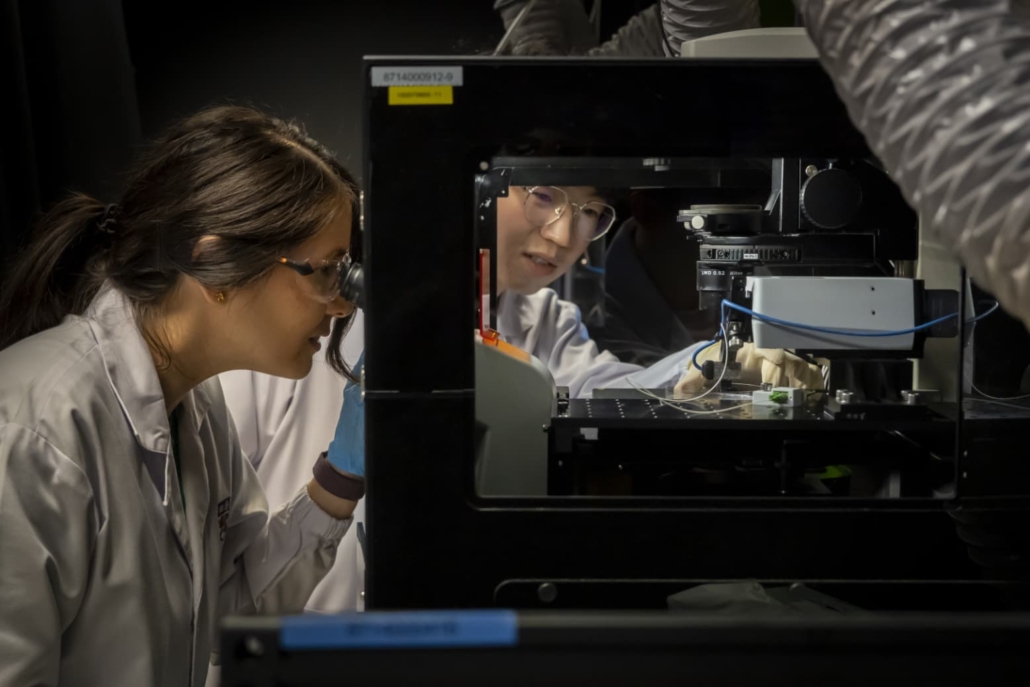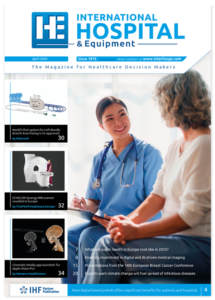Heart ageing could be reversible, breakthrough study reveals
Researchers at the National University of Singapore have developed a revolutionary biomaterial that demonstrates how environmental changes around heart cells could reverse age-related cardiac damage. The breakthrough research suggests that targeting the cellular environment, rather than the cells themselves, may offer new therapeutic pathways for heart rejuvenation.

Assistant Professor Jennifer Young (right) and PhD student Avery Rui Sun (left), who are from the College of Design and Engineering at the National University of Singapore, image heart cells (orange) on DECIPHER scaffolds (pink) using a confocal microscope to understand how cells interact with the extracellular matrix. © College of Design and Engineering at NUS
A groundbreaking study from the National University of Singapore (NUS) has revealed that some effects of heart ageing may be slowed and even reversed by modifying the cellular environment surrounding heart cells. The research, published in Nature Materials on 12 June 2025, could transform approaches to treating age-related cardiovascular disease.
Revolutionary biomaterial platform
The research team, led by Assistant Professor Jennifer Young from the Department of Biomedical Engineering at NUS, developed an innovative hybrid biomaterial called DECIPHER (DECellularised In Situ Polyacrylamide Hydrogel-ECM hybrid). This platform combines natural heart tissue with synthetic gel to closely mimic the stiffness and composition of the extracellular matrix (ECM) – the complex framework that surrounds and supports heart cells.
“Most ageing research focuses on how cells change over time,” said Assistant Professor Young. “Our study looks instead at the ECM and how changes in this environment affect heart ageing.”
The ECM acts as a net-like scaffolding made of proteins and other components that holds cells in place whilst sending chemical signals that guide cellular function. As the heart ages, this matrix becomes stiffer and its biochemical composition changes, triggering harmful activity in heart cells that contributes to scarring, loss of flexibility, and reduced function.

Assistant Professor Jennifer Young (left) examines a DECIPHER sample as PhD student Avery Rui Sun (right) adjusts the nanoindentation equipment used to measure the stiffness of the DECIPHER scaffold. © College of Design and Engineering at NUS
Decoupling mechanical and biochemical factors
Previous research has struggled to determine whether physical stiffness or biochemical signals play the greater role in cardiac decline, as these changes typically occur simultaneously. The DECIPHER platform addresses this limitation by allowing researchers to independently control stiffness and biochemical signals presented to cells.
“The DECIPHER platform solves this problem, allowing researchers to independently control the stiffness and the biochemical signals presented to the cells—something no previous system using native tissue has been able to do,” explained Avery Rui Sun, PhD student at NUS and first author of the study.
Biochemical environment trumps mechanical stiffness
The researchers made a remarkable discovery when they placed aged heart cells onto DECIPHER scaffolds that mimicked ‘young’ ECM cues. Even when the material remained stiff, the aged cells began behaving more like young cells, including shifts in gene activity across thousands of genes associated with ageing and cellular function.
Conversely, young cells placed on ‘aged’ ECM began showing signs of dysfunction, even on soft scaffolds. This demonstrated that the biochemical environment around aged heart cells matters more than stiffness, whilst young cells respond to both cues.
“Even when the tissue was very stiff, as it typically is in aged hearts, the presence of ‘young’ biochemical signals was enough to push aged cells back toward a healthier, more functional state,” Professor Young added. “This suggests that if we can find a way to restore these signals in the ageing heart, we might be able to reverse some of the damage and improve how the heart functions over time.”
Comprehensive molecular analysis
The study employed extensive molecular profiling, including RNA sequencing of cardiac fibroblasts and mass spectrometry of extracellular matrix proteins. The analysis revealed distinct age-dependent mechanisms of cardiac fibroblast activation, matrix remodelling, and senescence.
The authors noted in their discussion that “ECM ligand presentation can dictate myofibroblast activation state, outweighing the matrix stiffness cue.” This finding suggests that specific biochemical signals from the extracellular environment can override mechanical cues in determining cellular behaviour.
Implications for therapeutic intervention
For young heart cells, the research showed that higher stiffness can cause premature ‘ageing’, suggesting that targeting specific aspects of ECM ageing might slow or prevent heart dysfunction over time. The study’s findings indicate that therapeutic strategies focusing on restoring young biochemical signals could be more effective than approaches targeting mechanical properties alone.
The researchers demonstrated that maintaining native ECM architecture is crucial for cellular function. When they compared their DECIPHER scaffolds with conventional reconstituted ECM films, cells on the reconstituted materials showed higher activation and stress, underscoring the importance of preserving natural tissue architecture in biomaterial approaches.
Broader applications
The DECIPHER method shows promise beyond cardiac applications. “Many age-related diseases involve changes in tissue stiffness – not just in the heart,” said Professor Young. “For example, the same approach could be applied to kidney and skin tissue, and it could be adapted to study conditions like fibrosis or even cancer, where the mechanical environment plays a major role in how cells behave.”
Future directions
Whilst the work remains in the research phase, the team believes their findings open new directions for therapies aimed at preserving or restoring heart health during ageing by targeting the ECM itself. The study represents a significant advance in understanding how cellular and extracellular ageing interact, potentially leading to matrix-based rejuvenation strategies.
The research was a collaboration involving researchers from multiple NUS departments, including the Mechanobiology Institute, Department of Biological Sciences, Faculty of Science, Yong Loo Lin School of Medicine, and the Cardiovascular Research Institute at the National University Heart Centre Singapore.
Reference
Sun, A. R., Ramli, M. F. H., Shen, X., et. a;. (2025). Hybrid hydrogel–extracellular matrix scaffolds identify biochemical and mechanical signatures of cardiac ageing. Nature Materials. 12 June 2025. https://doi.org/10.1038/s41563-025-02234-6

